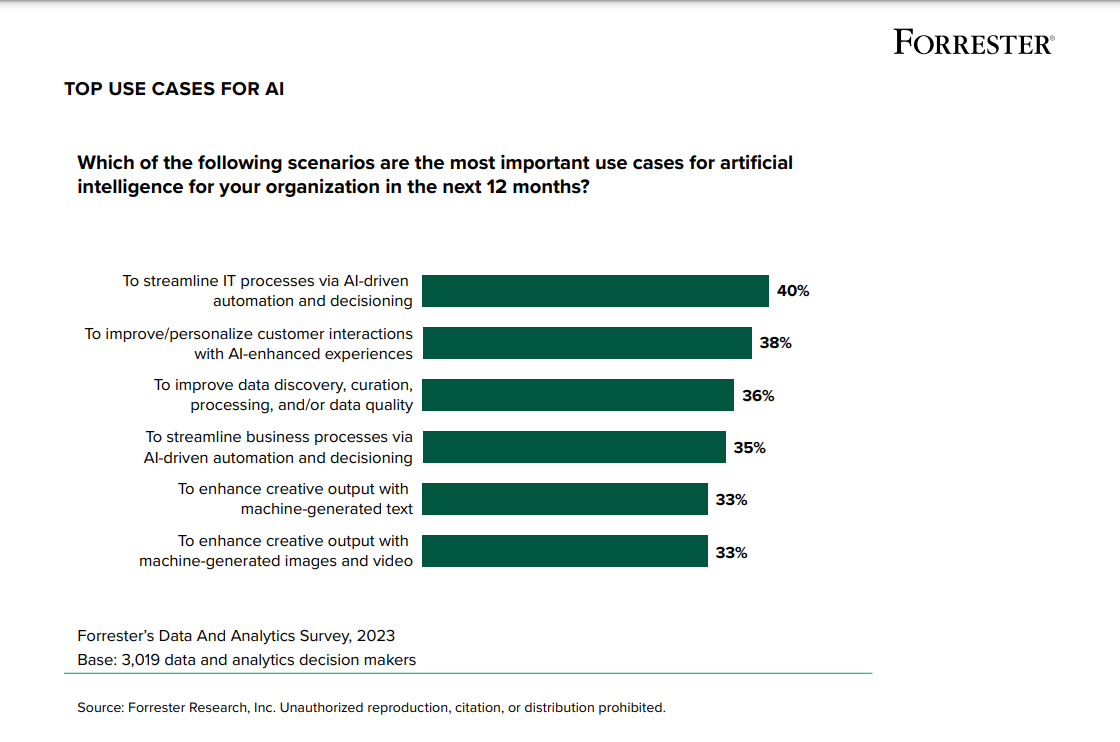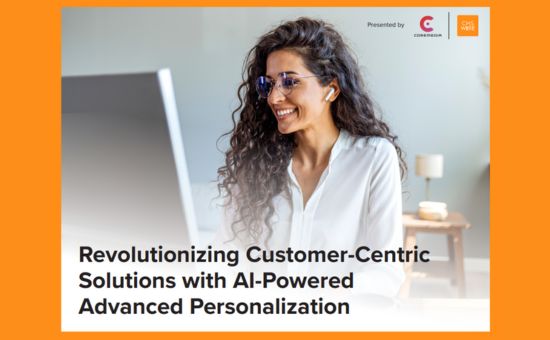Make The Most Of AI Adoption: Overcome Myths And Embrace AI Best Practices | Forrester
Artificial Intelligence
Since the release of ChatGPT in late 2022, AI progress has been rapid, surpassing typical industry standards. With numerous potential applications emerging, so do misconceptions and AI myths. To navigate common pitfalls and guide AI teams effectively, distinguishing between hype and reality is crucial.
Myth #1: AI Will Take Your Job Soon
There is a widespread belief that AI will swiftly replace human jobs, leading to widespread unemployment. A survey conducted by Forrester Research in 2023 revealed that 86% of US employees fear job loss due to AI and automation, with 31% anticipating it within the next two to five years.
Reality: While AI may indeed replace certain roles, its primary function is to enhance productivity rather than render humans obsolete. Similar to productivity software like word processors and accounting packages, AI is designed to optimize workflows and improve efficiency across various tasks.
For instance, AI can facilitate backlog management, streamline content creation, aid software development, and address labor shortages in regions with aging populations. Forecasts indicate a modest annual job loss of approximately 0.6% through 2030 due to automation and AI technologies.
However, the transformative potential of AI extends beyond job displacement, with projections suggesting that it will influence over 11 million US jobs, far surpassing those it directly replaces. Therefore, technology leaders should prioritize leveraging AI to augment workforce productivity and foster organizational growth.
Myth #2: AI Is Too Dangerous
There is a prevailing notion that the risks associated with AI outweigh its benefits, leading to apprehension and mistrust. Instances of biased algorithms, brand damage, and unethical AI utilization featured in the media contribute to the amplification of this myth.
Reality: While a trust deficit exists concerning AI, particularly in emerging technologies, it is imperative not to succumb to fear but instead to proactively address concerns.
Despite the potential for misuse by malicious actors, the solution lies in fostering trust through responsible AI deployment and governance. Implementing measures such as close oversight, A/B testing against traditional methods, and retaining human oversight can mitigate risks and enhance trust in AI systems.
Myth #3: AI Is Too Expensive
The perception persists that AI implementation is prohibitively expensive, primarily due to the high costs associated with training AI models and the scarcity of skilled AI developers.
Reality: Contrary to popular belief, AI vendors may inflate the perceived cost to promote their proprietary solutions. Moreover, the availability of open-source AI models and tools, along with advancements in AI technology, has democratized access and reduced implementation costs.
Rather than investing in large-scale models, organizations can leverage existing resources and tailor AI solutions to suit specific use cases.
Successful AI deployment hinges more on the maturity of the software development lifecycle than on the availability of expensive talent. Conducting a comprehensive cost-benefit analysis is crucial for evaluating the potential returns on AI investment and involving finance teams in the decision-making process.
Myth #4: Using Gen AI Will Suck The Creativity Out Of Your Organization
There is a misconception that the widespread adoption of AI, particularly generative AI (Gen AI), will stifle creativity within organizations, diminishing their competitive edge and innovative capacity.
Reality: While AI, including large language models like Gen AI, draws upon vast repositories of human knowledge, its role is not to supplant human creativity but to augment and facilitate it.
Rather than generating entirely novel ideas independently, AI serves as a collaborative tool, assisting creative teams in idea generation, content development, and evaluation.
By automating routine tasks and providing valuable insights, AI enables individuals to focus on higher-order creative endeavors, thereby enhancing productivity and innovation within organizations.

Seven Best Practices To Improve Your Chances Of AI Success
- Avoid overly ambitious AI use cases: If an AI use case resembles scenarios depicted in science fiction, it is likely to encounter failure. Successful applications of AI entail enhancing existing processes to achieve improved efficiency, cost-effectiveness, or both. For instance, integrating AI tools to assist nurses in patient monitoring and risk identification can yield substantial benefits, albeit appearing less groundbreaking to outsiders. Novel applications of advanced AI technologies, such as gen AI, should prompt caution among technology leaders. While the urge to expedite projects is understandable, it is essential to exercise prudence, particularly in deploying customer-facing applications, given the nascent stage of this technology.
- Prioritize projects in the sweet spot of business value and technical feasibility: Many organizations fall prey to pursuing AI projects that lack both practical value and feasibility, influenced by media sensationalism and exaggerated vendor marketing. To mitigate this risk, it is crucial to assess project scopes based on their alignment with organizational objectives and technical feasibility concurrently. Collaboration between business and technical experts is beneficial, but the inclusion of “interpreters” with proficiency in both domains enhances project success. Additionally, project scoping should entail defining metrics for business value, including anticipated benefits within a specified timeframe, and evaluating the utilization of existing data and workforce resources.
- Plan AI projects with the full AI lifecycle in mind: The success of new AI solutions hinges on user adoption and utilization. Deploying AI solutions encompasses more than mere deployment; it necessitates ongoing support, maintenance of production models, and user training. Failure to plan comprehensively may result in prolonged delays or projects languishing in obscurity. Initiating AI projects with a holistic approach and establishing trust with intended end users from inception enhances the likelihood of long-term success.
- Improve your data iteratively: Managing data in AI projects is a continual process, not a one-time endeavor. Identifying requisite data and its suitable format is contingent upon understanding its intended application. Delaying AI projects for comprehensive information architecture initiatives proves futile, as the data may not align with project requirements upon completion. Instead, leveraging available data to drive immediate value and advocating for subsequent investments in data assets and pipelines based on project successes is prudent.
- Use quick wins to build out your AI capabilities: Successful AI initiatives capitalize on available capabilities to deliver rapid value, subsequently justifying investments in enhanced skills, platforms, and processes. This often entails initially procuring point solutions with embedded AI capabilities before transitioning to bespoke models and applications.
- Actively counter your human biases, then worry about biased AI: Bias in AI poses a significant challenge to fostering broad trust in AI applications. Proactively identifying and mitigating biases in training data, soliciting diverse perspectives from technical and subject-matter experts, testing multiple hypotheses, validating models, and monitoring them for bias and fairness are imperative. Neglecting these measures risks perpetuating bias, whereas adherence to rigorous testing and validation protocols ensures that resulting models are less biased than human decisions.
- Kill zombie AI projects: Despite organizational efforts to streamline operations, dormant AI projects can persist due to misguided objectives or inadequate oversight. These “zombie” projects drain resources and impede innovation. Empowering teams to discontinue such projects while capturing insights for future iterations is essential to maintaining organizational agility and driving successful AI implementations.
Unlock the secrets to leveraging AI effectively and avoiding common pitfalls with our exclusive guide. Gain insights from industry experts and discover best practices for maximizing the impact of AI on your organization. Don’t miss out on this invaluable resource – download now to embark on your AI journey with confidence!
Download Our Comprehensive Guide to Navigating AI Implementation Successfully!
The Table of Contents of “Avoid Common AI Myths And Focus On Best Practices” Guide:
- Myth #1: AI Will Take Your Job Soon
- Myth #2: AI Is Too Dangerous
- Myth #3: AI Is Too Expensive
- Myth #4: Using Gen AI Will Suck The Creativity Out Of Your Organization
- Seven Best Practices To Improve Your Chances Of AI Success
- Avoid overly ambitious AI use cases.
- Prioritize projects in the sweet spot of business value and technical feasibility.
- Plan AI projects with the full AI lifecycle in mind.
- Improve your data iteratively.
- Use quick wins to build out your AI capabilities.
- Actively counter your human biases, then worry about biased AI.
- Kill zombie AI projects.
Number of Pages:
- 8 pages
Pricing:
- Free






